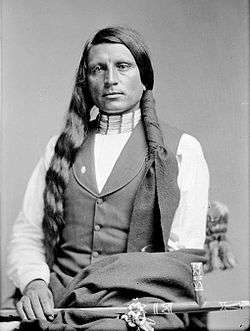Red Shirt (Oglala)
| Red Shirt | |
|---|---|
|
Chief Red Shirt | |
| Oglala Lakota leader | |
| Personal details | |
| Born |
1847 near Fort Fetterman, Wyoming |
| Died |
January 4, 1925 Pine Ridge Reservation, South Dakota |
| Spouse(s) | In Sight |
| Children | Annie Red Shirt, William Red Shirt, Joseph Red Shirt, II |
| Known for | Oglala chief, warrior and statesman. Served on peace delegations, international celebrity with Buffalo Bill's Wild West. |
Red Shirt (Oglala Lakota: Ógle Lúta in Standard Lakota Orthography) (a/k/a "Ogilasa" and "Joseph Red Shirt") (1847-January 4, 1925) was an Oglala Lakota chief, warrior and statesman. Red Shirt is notable in American history as a U.S. Army Native Scout and a progressive Oglala Lakota leader who promoted friendly associations with whites and education for his people. Red Shirt opposed Crazy Horse during the Great Sioux War of 1876-1877 and the Ghost Dance Movement of 1890, and was a Lakota delegate to Washington in 1880. Red Shirt was one of the first Wild Westers with Buffalo Bill’s Wild West and a supporter of the Carlisle Native Industrial School. Red Shirt became an international celebrity Wild Westing with Buffalo Bill’s Wild West and his 1887 appearance in England captured the attention of Europeans and presented a progressive image of Native Americans.
Early life
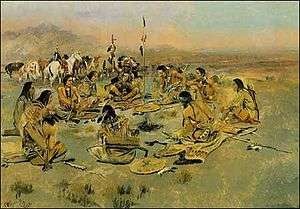
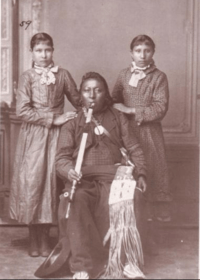
Red Shirt was born near Fort Fetterman, Wyoming. There are several accounts of Red Shirt's early life. One account is that Red Shirt is the son of a white man and a Lakota mother.[1] Another account, by Red Shirt, is that he was the son of a great warrior chief.[2] Will Rogers reported that Red Shirt was the son of Red Dog, a progressive headman of the Oyuhpe band who settled at Pine Ridge, South Dakota.[3] Red Shirt and Red Dog were Lakota delegates to Washington in 1880, served as Pine Ridge Indian Police and sent their children to the Carlisle Native Industrial School in Carlisle, Pennsylvania. Historians agree that by 1877 Red Shirt had emerged as a leader of the Wagluhe at Pine Ridge.[4]
U.S. Army Native Scout

Red Shirt was a U.S. Army Native Scout with U.S. 4th Cavalry Regiment during the Great Sioux War of 1876-77[5] and emerged as a "up and coming" Wagluhe leader.[6] During this time, the Wagluhe split into three bands, those of American Horse, Blue Horse and Three Bears. Red Shirt served as Three Bears’ lieutenant, and officially became a chief in 1879 at Pine Ridge Agency. In 1879, Red Shirt also became a chief of the Pine Ridge Police, and continued in that capacity at least through 1910.[7] In 1880, Red Shirt traveled to the Carlisle Native School with Red Cloud and Red Dog and on to Washington D.C. as a Lakota delegate.[8]

Red Shirt the Warrior
Although many consider him not a part of the Battle of the Little Bighorn that is still up for debate. Most of Red Shirt's history has been written down. Living family members of his tell of his bravery in battle. Buffalo Bill Cody was impressed with Red Shirt. “Among the prominent chiefs thus engaged was Red Shirt, a redoubtable warrior and second only in influence to Sitting Bull himself. A short while before his engagement with us he had quelled an uprising among his people, instigated by a pretender to the chieftainship of the tribe, by invading the pretender's camp with only two of his followers and shooting the leader dead before the eyes of his affrighted wife. This fearless act had served to elevate him very much in the eyes of his people, who thereafter accepted him as a leader. When, therefore, he decided to join the Wild West show, under the flattering offers I made him, his influence aided us very much in procuring our complement of Indians, not only from his own tribe, but from others as well.” [9]
Carlisle Native Industrial School
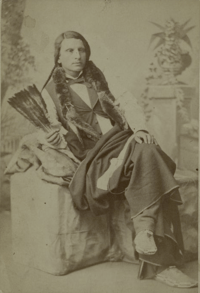

The Carlisle Indian Industrial School in Carlisle, Pennsylvania, was a unique school, and is considered by some Native Americans like going to Yale, Princeton or Cambridge.[10] In 1879, Red Shirt, along with Blue Horse and American Horse, enrolled their children in the first class at Carlisle Indian Industrial School in Carlisle, Pennsylvania. They wanted their children to learn English, trade skills and white customs. "Those first Sioux children who came to Carlisle could not have been happy there. But it was their only chance for a future." [11] Wild Westing and the Carlisle Indian School were portals to education, opportunity and hope, and came at a time when the Lakota people were depressed, impoverished, harassed and confined. Many Wild Westers from Pine Ridge enrolled their children at the Carlisle Native Industrial School from its beginning in 1879 until its closure in 1918.[12]
Wild Westing
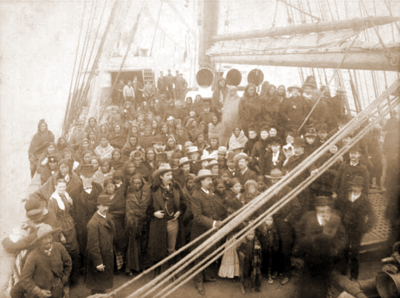
On March 31, 1887, Chief Red Shirt, Chief Blue Horse and Chief American Horse and their families boarded the S.S. State of Nebraska in New York City, leading a new journey for the Lakota people when they crossed the sea to England on Buffalo Bill’s first international to perform at the Golden Jubilee of Queen Victoria and tour through Birmingham, Salford and London over a five–month period. The entourage consisted of 97 Indians, 18 buffaloes, 2 deer, 10 elk, 10 mules, 5 Texas steers, 4 donkeys, and 108 horses. Buffalo Bill treated Native American employees as equals with white cowboys. Wild Westers received good wages, transportation, housing, abundant food and gifts of clothing and cash from Buffalo Bill at the end of each season. Wild Westers were employed as performers, interpreters and recruiters. Men had money in their pockets and for their families on the reservation. Female performers were paid extra for infants and children and supplemented wages by making and selling Lakota crafts.[13] Shows hired venerable elder male Natives to appear in the parades to ensure that young men acted with consideration and politeness when visiting host communities, and rules were self-policed by traditional Oglala Lakota chiefs and former U.S. Army Native Scouts.[14] Known as “Show Natives”, Oglala Wild Westers referred to themselves as "Oskate Wicasa" or "Show Man", a title of great honor and respect.[15] Since 1887, Wild Westing has been family tradition with several hundred Pine Ridge families, and the tradition of the Wild Wester community is not unlike the tradition of circus families and communities.[16]
Crossing the Sea
Before starting on the trip to England in 1887, several of the Indians expressed grave fears that the great waters soon overtake them a bring a horrible death. Red Shirt explained that these fears were caused by a belief prevalent among many tribes of Natives, that if a red man attempted to cross the ocean, soon after beginning his journey he would be seized of a malady that would first prostrate the victim, and then slowly consume his flesh day after day, until at length the very skin itself would drop from his bones, leaving nothing but the skeleton and this even could never find burial. On the day following the departure from New York, the Indians began to grow weary and their stomachs became both treacherous and rebellious. Their fears were now so greatly intensified that even Red Shirt, the bravest of his people, began to feel his flesh to see if it were really diminishing. Buffalo Bill, "used his utmost endeavors to cheer them up and relieve their forebodings. But for two days nearly the whole company was too sick for any other active service than feeding the fishes, in which I am not proud to say that I performed more than an ordinary share. On the third day, however, we all began to mend so far that I called the Natives together in the main saloon and gave them a Sunday address, as did also Red Shirt, who was now recovered from his anxiety about the future.[17]
Red Shirt in England
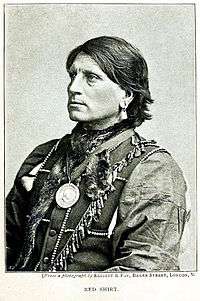
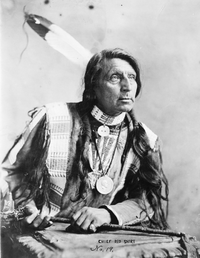
Chief Red Shirt was lionized by the British press and photographed by reporters wherever he went. His handsome features and stately bearing caused reporters to hang on his every word and he became the most quoted Wild Wester celebrity of Cody’s trip to England.[18] Red Shirt explained to a reporter from Sheffield: “I started from my lodge two moons ago knowing nothing, and had I remained on the Native Reservations, I should have been as a blind man. Now I can see a new dawn. I have seen the great houses (ships) which cross the mighty waters, the great villages which have no end where the pale faces swarm like insects in the summer sun. Our people will wonder at these things when we return to the Native Reservation and tell them what we have seen.”
Statesman
Red Shirt adopted a show business persona and proved to be a statesman. Red Shirt presented an image of Native Americans that Europeans could associate with progress, nobility, and civilization. Queen Victoria adored Chief Red Shirt and requested a special command performance.[19] Red Shirt commented to The Brisbane Courier on the future of Natives in the United States. "The red man is changing in every season. The Native of the next generation will not be the Native of the last. Our buffaloes are nearly all gone, the deer have entirely vanished, and the white man takes more and more of our land. But the United States government is good. True, it has taken away our land, and the white man have eaten up our deer and our buffalo, but the government now gives us food that we may not starve. They are educating our children and teaching them to use farm implements. Our children will learn the white man’s civilization and to live like him. It is our only outlook in the future. Now we are dependent upon the rations of the Government but we feel we are fully entitled to that bounty. It is a part of the price they pay for the land they have taken from us, and some compensation to us for having killed off the herds upon which we subsisted. For myself, I know it is no use fighting against the United States government. I accept my fate. The red man cannot kill all the white men that live in villages as big as the largest forests. But some of our young men do not know this, and they may perhaps elect to die like their fathers with their tomahawks in their hands rather than starve to death like a dog upon the prairie." [20]
Visitors to Earl’s Court

The royal party inspected the Indian encampment after a performance and Prince Albert Edward had an extended conversation with Red Shirt. Princess Alexandra, through an interpreter, welcomed Chief Red Shirt and other Wild Westers to England. The chief, with great dignity, responded: "Tell the Great White Chief 's wife that it gladdens my heart to hear her words." On April 28, 1887, William Ewart Gladstone, former Prime Minister and current leader of the opposition party in Parliament, toured the Wild West show grounds with his wife at Earl's Court and spoke at length with Red Shirt. Red Shirt was impressed with Gladstone.
“When I saw the great White Chief I thought he was a great man. When I heard him speak, then I felt sure he was a great man. But the White Chief is not as the big men in out tribes. He wore no plumes and no decorations. He had none of his young men (warriors) with him, and only that I heard him talk he would have been to me as other white men. But my brother Mr. Gladstone came to see me in my lodge as a friend, and I was glad to see the White Chief, for though my tongue was tied in his presence my heart was in full friendship. After he went away they told me that half of his great nation of white men have adopted him as their chief. If he were not both good and wise, so many young men of his nation would have never taken him for their leader.” [21]
Grandmother England
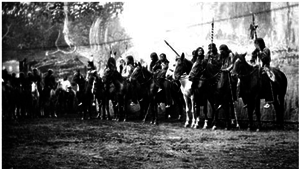
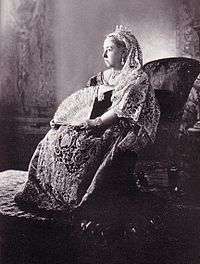
On May 9, 1887, Buffalo Bill's Wild West opened in London. Among the audience members was Queen Victoria, who visited the Earl's Court encampment three days later. Black Elk recalled that Natives were told "that Majesty was coming. I did not know what that was at first, but I learned afterward. It was Grandmother England who owned Grandmother's Land where we lived awhile after the Wasichus murdered Crazy Horse." Red Shirt expressed his pleasure in meeting the Queen and remarked to her that "I have come many thousands of miles to see you. Now that I have seen you, my heart is glad." The encounter and his words were widely circulated among the press and noted in her diary. Since the death of Prince Albert, her husband, which event had occurred thirty years previous to this "command," the queen had been more than ordinarily seclusive. She seldom appeared before great assemblages of her subjects and her visits to even her parliament were rare. To theatrical performances she never went during that long period of her mourning. Her latest knowledge of the greatest actors and actresses of the time was gained by private performances given, by command, in her court, and these were infrequent. "The Wild West was altogether too big a thing to take to Windsor Castle, and as in the case of Mahomet and the mountain, as the Wild West could not go to the Queen it became absolutely necessary for the Queen to go to the Wild West, if she desired to see it, and it was evident that she did."[22] "Then I presented Red Shirt, the Native Chieftain, who was gorgeous in war paint and feather trappings. His proud bearing was fetching among the royal party, and when he spoke through an interpreter, saying he had come a long way to see her Majesty and "felt glad," the Queen smiled appreciatively, and as the red man, unconventionally, but proudly, strolled away with the dignity of a Supreme Court Judge, she seemed to say, "I know a real prince when I see him."[23] "Every act went with a rush and a cheer, and was received by cries of 'bravo,' 'well done,' etc. At the close of the exhibition calls were made for Red Shirt and myself, in response to which I thanked my patrons and assured them that the recollection of that evening's display of kindness would ever be fresh in my memory. Cries of 'Bravo, Bill,' and the singing of 'For he's a jolly good fellow' by the entire audience brought the demonstration to a close." [24]
Goethe's Faust at the Lyceum Theater
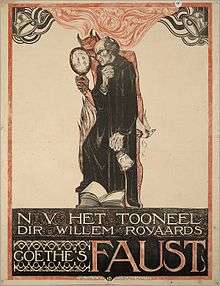
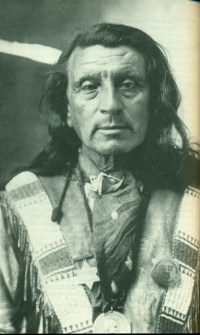
Shortly after arriving in London, Cody took some of his Wild Westers to see Sir Henry Irving's production of Goethe's Faust at the Lyceum Theater. The London Times reported that the Sioux were greatly frightened by its horror. In the premier theater of London, Red Shirt, considered the "Chief of the Show Natives by the press, was seated in the royal box suggesting an aura of nobility for the cowboys and Natives in attendance. Irving used the occasion to his own advantage, inviting the performers onstage after the show. Irving remarked to the theatrical paper Era that it was novel to "see Native chiefs in the full panoply of war–paint, holding the scalp–fringed banner in one hand and eating sugar plums with the other." Red Shirt remarked that the show reminded him of a dream. The Sioux, who did not believe in a hell, took the fantastic scenes of Hades, according to their interpreter, “for what it’s worth,” a Wasichu’s dream.
Red Shirt’s Vision at Westminster Abbey
"The white man’s lodges for the Great Spirit, whose pinnacles reach the sky, and which have stood for more seasons than the red man reckon, all struck me with terrible wonder. And the Great Spirit speaks to me sometimes since I have been here. When I was in the Great Spirit Lodge (Westminster Abbey) where the kings are buried, I laid my face upon my hands. The words of the preacher I did not know, but they sounded like the softy winds through a leafy forest and my eyelids were heavy. Then I heard soft music and sweet voices, and a great cloud came down towards me, and when it nearly touched me, it opened and I saw in a blaze of light the girls with wings and they beckoned me. And I was so certain that what I saw was that, I called out to my young men who were with me ‘Come and see what this is,’ and the young men replied, “You have been dreaming.’ But what I saw was true, for when I looked around the great lodge afterwards, I saw on the walls the same girls with wings as I saw in my dreams. Our people will wonder at these things, when we return to the Native Reservation and tell them what we have seen.” [25]
English Hospitality
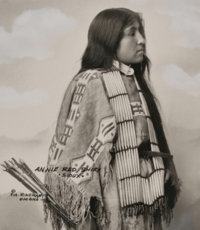
The London Courier reported Red Shirt and companions were treated to an evening of English hospitality. “Willesden was as it were taken by storm on Sunday last, being invaded by the Indian contingent of Buffalo Bill’s Wild West Show. The fact was that Mr. T.B. Jones, of the White Hart Hotel had, as another instance of his great geniality, invited Red Shirt, Blue Horse, Little Bull, Little Chief and Flies Above and about twenty others to an outing to his well-known hostelry, whereabout they might enjoy his bounteous hospitality. In carriage and brake, provided by my host, these celebrated chiefs, along with their swarthy companions, with faces painted gaily, bedizened and bedangled with feathers and ornaments, and clad in their picturesque garments, accompanied by their chief interpreter, Broncho Bill and other officials, reached the White Heart about half-past 12 o’clock.”[26]
Surrounded By the Enemy's funeral
In 1887, Buffalo Bill and his Wild West camped in the City of Salford, England, for five months. While in Salford, a Wild West gun-slinging and horse-riding stuntman known as Surrounded By the Enemy died from a chest infection, probably caused by the chilly weather, in his teepee at the Salford Quays. "Surrounded" was described as six feet seven inches tall, aged 22 and an imposing sight of a Sioux warrior. There was no recorded church burial, and it is believed that Surrounded was buried in a traditional Sioux ceremony conducted by Red Shirt and Black Elk. The Oglala Lakota connection lives on in Salford with street names such as Buffalo Court and Dakota Avenue.[27]
The Eiffel Tower

In 1889, Cody's Wild West spent six months in Paris. On the centennial of the fall of the Bastille, a group of Wild Westers ascended the Eiffel Tower. From the observation plat, Red Shirt surveying Paris below him and the sky above, remarked "If people look so little to us up here, how much smaller they must seem to One "Wakantanka" who is up higher." [28]
Final Days
Wild Westing was Chief Red Shirt's main economic support for the next several decades.[29]
Chief Red Shirt died in 1925 at the age of 77 and is buried at Pine Ridge, South Dakota.
Red Shirt Table

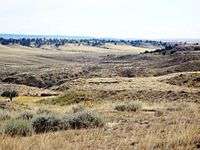
Red Shirt Table is a table mountain in Oglala Lakota County, South Dakota, and part of the Pine Ridge Native Reservation of the Oglala Sioux Tribe. The table, named after Chief Red Shirt is approximately 10 miles (16 km) long, generally extending in a north-south direction, and is located along the western boundary of Badlands National Park's Stronghold Unit. The park's highest point is located at the southern end of the table at 3,340 feet (1,020 m).[30] The irregularly shaped southern portion of the table is connected to the more rectangular northern portion by a narrow section less than 800 feet (240 m) wide; the northern portion is up to two miles (3 km) wide and is composed of two elongated lobes with a runoff channel between them. The top surface of the table slopes gently downhill as it extends northward, with the north edge being at about 2,800' in elevation. It drops off steeply from almost all sides, up to 300'. French Creek flows to the northeast, and the intermittent Cedar Creek drains the entire east side of the table.
Red Shirt Table is one of many tables in the White River Badlands. Others include Cuny Table, Sheep Mountain Table, and Heck Table.
The Oglala Lakota community of Red Shirt is located below the north end of the table in the Cheyenne River valley in the Pine Ridge Indian Reservation.
Red Shirt Wilderness Area
Buffalo Gap National Grassland located primarily in southwestern South Dakota, United States, is the second largest National Grassland in the country and covers almost 600,000 acres. The area is mixed prairie and chalky badlands and managed by the U.S. Forest Service. Within this grassland, the Cheyenne River watershed contains some of the finest examples of potential prairie wilderness left in the nation, including the largest remaining roadless area in the Great Plains. Three areas—Red Shirt, Indian Creek, and Chalk Hills—have been proposed for wilderness designation by the South Dakota Wild Grassland Coalition, which is working hard to protect these areas as a legacy to South Dakotans. Red Shirt comprises approximately 16,000 acres and is characterized by colorful striped buttes, mounds and cones rising to stunning grassy plateaus and ridge lines, with Schumacher Canyon and its exposed layers of color-banded clays on steep slopes as its centerpiece. It is northwest of the Pine Ridge Native Reservation and was used by the Lakota for shelter, food, medicinal plants, and burial sites until the Native Wars ended. One can still find remnants of that time throughout the area. Red Shirt borders Black Hills National Forest, where the contrast in landscapes is marked. Black Elk Wilderness, which lies within the forest, contains Black Elk Peak, the highest U.S. pinnacle east of the Rocky Mountains. Hikers can get a stunning view of this from Red Shirt.[31]
Red Shirt, South Dakota
Red Shirt, South Dakota, is named after Chief Red Shirt.
External links
- http://www.american-tribes.com/Lakota/BIO/RedShirt.htm
- http://www.redshirtproject.org/why.html
- http://www.pewenvironment.org/news-room/other-resources/south-dakotas-red-shirt-proposed-wilderness-85899442712
References
- ↑ http://amertribes.proboards.com/thread/1854/chief-red-shirt#ixzz2ZsPXbiJy
- ↑ In an interview, Red Shirt said his father was a great chief, and that he was eager to prove himself a great warrior in his eyes. The Brisbane Courier, “The Sioux Chief Red Shirt Interviewed”, June 23, 1887.
- ↑ Arthur Frank Wertheim and Barbara Bair, ed., The Papers of Will Rogers: Wild West and Vaudeville, April 1904-September 1908, (2000), p. 62.
- ↑ Eli Seavey Ricker and Richard E. Jensen, “Voices of the American West: The Indian interviews of Eli S. Ricker, 1903-1919, Volume 1, p.15 (2005).
- ↑ Bourke, John (1966). Mackenzie's Last Fight with the Cheyennes. Argonaut Press Ltd. p. 23.
- ↑ The Wagluhe were considered by the U.S. Army and Indian agents to be the most progressive band of Lakota and many became U.S. Army Indian Scouts with the U.S. 4th Cavalry Regiment and intermediaries with other bands of Lakotas. The Wagluhe first formed a civil administration at Ft. Laramie and Old Chief Smoke appointed Chief Blue Horse and Chief Big Mouth the first Native Police officers. The U.S. Army concluded that, even if there were doubts about their reliability, the Wagluhe’s role as scouts, civil administrators and mediators was absolutely essential. The Wagluhe were the first Oglala Lakota to send their children to the Carlisle Indian Industrial School in Carlisle, Pennsylvania, for a formal education, and the first to go Wild Westing with Col. "Buffalo Bill" Cody and his Wild West. Former U.S. Army Native Scouts and traditional Lakota law enforcers (akicitas) filled the ranks of the early Pine Ridge police force. In 1876 and 1877, more than five hundred Lakotas had served as army scouts in the Nez Perce campaign and in the pursuit of their tribesmen after the Battle of the Little Bighorn. Mark R. Ellis, “Reservation Akicitas: The Pine Ridge Indian Police, 1879-1885" (hereinafter "Ellis"), South Dakota History, Vol. 29, No. 3, (1999), p. 187-190.
- ↑ Red Shirt and Red Dog were listed on the police roster as members of the Oyuhpe Band. Ellis, p. 200. “Chief Red Shirt Quits Footlights”, New Castle News, July 12, 1910.
- ↑ Herman J. Viola, Diplomats in Buckskins: A History of Native Delegations in Washington City, 1995.
- ↑ Buffalo Bill and William Lightfoot Visscher, The Life and Adventures of Buffalo Bill , (hereinafter "Buffalo Bill"), (1917), p. 316.
- ↑ Witmer, p.xvi. Carlisle had developed something of a rivalry with Harvard, and though the Natives had never beaten the Crimson, they always gave them a game. The Indians both admired and resented the Crimson, in equal amounts. They loved to sarcastically mimic the Harvard accent; even players who could barely speak English would drawl the broad Harvard a. But Harvard was also the Natives' idea of collegiate perfection, and they labeled any excellent performance, whether on the field or in the classroom, as "Harvard style." Sally Jenkins, “The Real All Americans”, (hereinafter "Jenkins")(2007), p.198.
- ↑ Ann Rinaldi, “My Heart is on the Ground: the Diary of Nannie Little Rose, a Sioux Girl, Carlisle Native School, Pennsylvania, 1880,” (1999), p. 177.
- ↑ Alida S. Boorn, “Oskate Wicasa (One Who Performs)” (hereinafter “Oskate Wicasa”), Department of History, Central Missouri State University, (2005), p.131.
- ↑ Calls the Name and other women supplemented wages by making and selling Lakota crafts. Women served important community roles in camps backstage. Augmenting their show wages was common among Show Indians, especially "'bead work' made into moccasins, purses, etc.," which earned them "very large prices," according to Nate Salsbury. Cody and Salsbury often purchased goods at wholesale prices and sold the goods to Indians at cost, allowing them to create souvenirs for tourists. Show Indians created and sold goods to museums, collectors, and customers across Europe and the United States. Jason Heppler, “Buffalo Bill’s Wild West and the Progressive Image of American Natives”, http://segonku.unl.edu/~jheppler/showindian/. Performers’ newborn babies became part of the villages set up outside show areas. Oskate Wicasa, p.164.
- ↑ Oskate Wicasa, p.6, 54. The number of police chosen depended on the number of Natives traveling with the show each season, a usual ration being one policeman for every dozen Natives. Native policemen selected from the ranks of the performers were given badges and paid $10 more in wages per month. in 1898, Chief Iron Tail managed the Native Police. Michele Delaney, “Buffalo Bill’s Wild West Warriors: A Photographic History by Gertrude Kasebier, Smithsonian National Museum of American History”, (2007), p.32.
- ↑ Oskate Wicasa is a colloquialism meaning “one who performs.” Its usage began in the early days of the Buffalo Bill Cody Wild West Shows. Oskate Wicasa, p.1. The phrase "Show Natives" likely originated among newspaper reporters and editorial writers as early as 1891. By 1893 the term appears frequently in Bureau of Native Affairs correspondence. Some believe that the term is derogatory describing the "phenomenon of Native exploitation and romanticization in the U.S." Arguments of a similar nature were made by the Bureau of Native Affairs during the popularity of Wild West shows in the U.S. and Europe. L.G. Moses, p. 219.
- ↑ American Horse’s sons Ben American Horse and Samuel American Horse were Carlisle Wild Westers and interpreters. Between 1906 and 1915, 570 individuals from Pine Ridge went Wild Westing with Buffalo Bill and other shows. Oskate Wicasa, p.164. L.G. Moses, “Wild West Shows and the Images of American Natives, 1883-1933,” (1996), p. 33 , 242.
- ↑ Buffalo Bill, p. 318-319.
- ↑ Oskate Wicasa, p.67. By the Columbian Exposition (1893) he was the most famous Wild Wester in the world. p.43-44.
- ↑ “Could building site be burial ground of the lost warrior from Buffalo Bill's show?, Daily Mail, August 16, 2007.
- ↑ The Brisbane Courier, “The Sioux Chief Red Shirt Interviewed”, June 23, 1887.
- ↑ Buffalo Bill, p. 49-50.
- ↑ Buffalo Bill, p. 330-331.
- ↑ Buffalo Bill, p. 333.
- ↑ Buffalo Bill, p. 335.
- ↑ The Brisbane Courier, “The Sioux Chief Red Shirt Interviewed”, June 23, 1887.
- ↑ The Courier (London), September 1, 1887, p.10.
- ↑ "Could building site be burial ground of the lost warrior from Buffalo Bill's show?", Daily Mail, August 16, 2007 http://forums.canadiancontent.net/history/66250-could-british-burial-ground-sioux.html
- ↑ Moses, p. 82-83.
- ↑ http://www.franksrealm.com/Native American/tribes/Sioux_Lakota/Oglala/pages/oglala-redshirt.htm
- ↑ "U.S. National Park High Points". Peakbagger.com. Retrieved 2008-03-17.
- ↑ http://www.pewenvironment.org/news-room/other-resources/south-dakotas-red-shirt-proposed-wilderness-85899442712#sthash.O87f1RqT.dpuf
